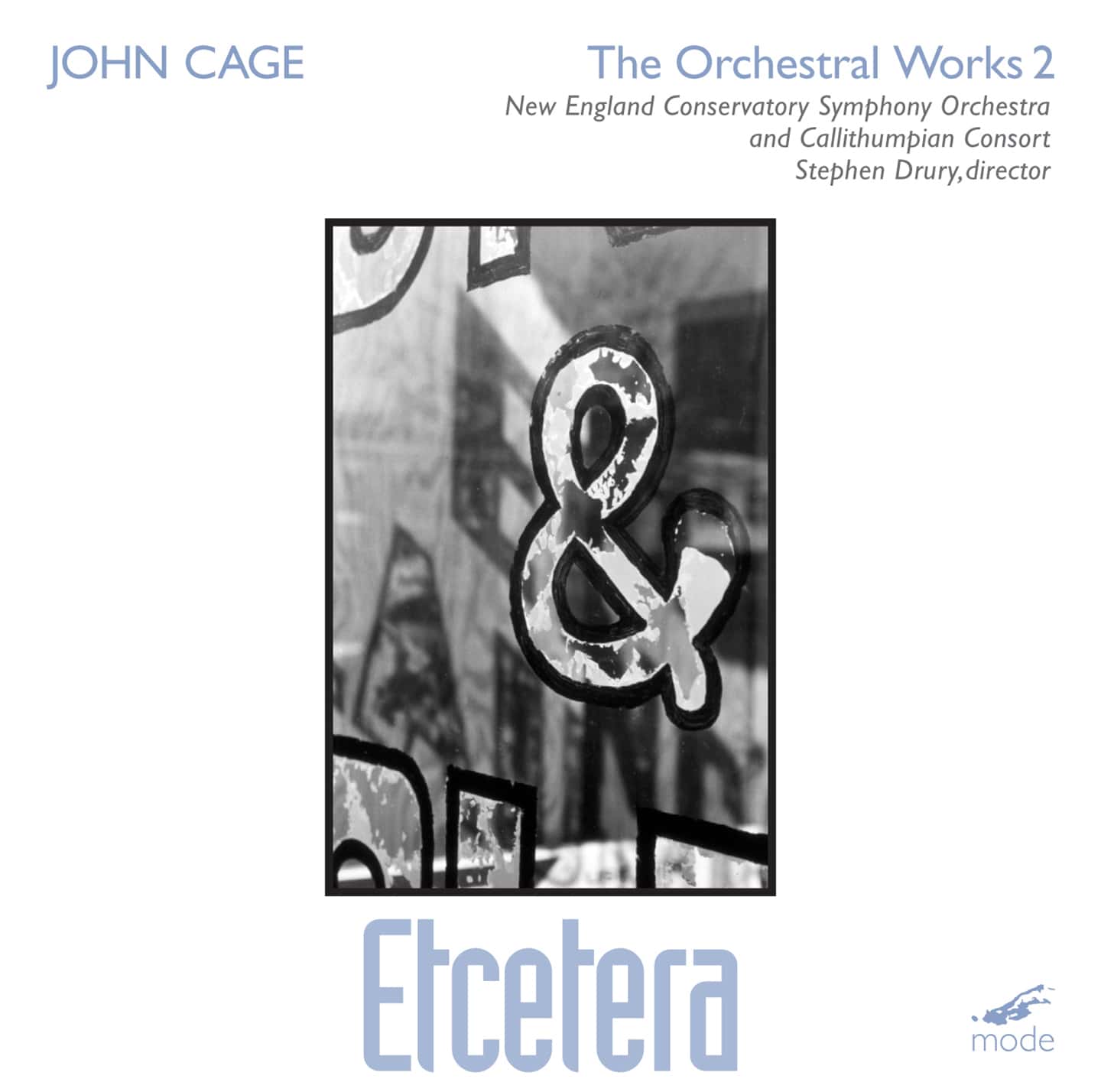Cage Edition 21-Orchestral Works 2
Cage Edition, Volume 21
New England Conservatory Orchestras
Stephen Drury, director
ETCETRA (1973) 20:44
for chamber orchestra with 3 conductors
Callithumpian Consort of New England Conservatory
Tamara Brooks, Stephen Drury, Charles Peltz, conductors
ETCETERA 2/4 ORCHESTRAS (1986) 30:08
for large orchestra divided into 4 smaller ensembles with their own conductors
New England Conservatory Symphony Orchestra
Tamara Brooks, Marsha Hassett, Charles Peltz, Laurie K. Redmer, conductors
First recordings!
The first recording of two major orchestral works by John Cage, recorded under the composer’s supervision at the New England Conservatory’s John Cage Festival in 1991.
These works are about “multiplicity”-of performing options, of ensembles, of conductors; tape music or live music, standard or unconventional notation, repetition or non-repetition. Each piece also contains a tape recording of the environment where the work was created-in the country for ETCETERA, the city for ETCETERA 2/4 ORCHESTRAS.
In ETCETERA, the players begin without conductor, then move at their option to any of three positions on stage to play conducted music with others. They begin by tapping rhythms on cardboard boxes, suggesting the sound of rain on the accompanying tape of the environment at Stony Point, New York.
In ETCETERA 2/4 ORCHESTRAS, the players begin under a conductor, and at their option move to an unconducted soloist position: the “melodic” station.
The ensembles are directed by Cage specialist Stephen Drury.
Reviews
John Cage
The Orchestral Works, Volume 2
Etcetera (1973); Etcetera 2/4 Orchestras (1986)
New England Conservatory Symphony &
Callithumpian Consort/Stephen Drury(50:52, DDD)
* * * * * Sound
* * * * Performance
Verdict: An important release, but mainly one for Cage buffs
Even conventional notation is no more than a rough guide to the music which composers hear in their heads, but at least it represents a consensus based on codified pitches, velocities and volumes. In the twentieth century, every composer created their own additional symbols to indicate new sounds and to help performers realise these unfamiliar sounds. Sometimes musicians were permitted, even expected, to contribute to the creation as well as the realisation of the music. These works find Cage presenting conventional notation for some elements, such as dynamics in the earlier piece and chords in the later, while inviting the performers to shape the pieces by choosing which of several groups or stations to align themselves with. The results often sound like Stockhausen’s “intuitive” pieces, and raise the questions about the role of the composer, which was what Cage had intended. For most listeners, the interest is in the processes, since these pieces are short on tunes and harmonic cushions.
— Barry Witherden, Classic CD, September 2000
John Cage
The Orchestral Works 2
Il dispositivo per Etcetera del 1973 e per Etcetera 2/4 Orchestras del 1986 è all’incirca lo stesso. Ne primo lavoro ci sono tre direttori, ne secondo quattro. Più spesso non dirigono, al massimo coordinano gruppi di orchestrali a cui sono affidate parti assai variabili a seconda della collocazione nella sala, del tipo di sala, ecc Da perfetto anarchico (non nichilista), quindi, I modi di interpretazione previsti dall’autore. E la musica? Siamo nel regno di spasmodica tensione verso il non detto che, appunto per questo suo paradossale statuto nel mondo della comunicazione, ha molto da dire. Siamo, in entrambi di lavori, nel desiderio di attingere << la musica prima della musica >> come diceva Cage, ma non attraverso il silenzio o gli immensi vuoti di suono, bensi attraverso una piacevolissima staticità e << insignificanza >> delle frasi musicali che appaiono in scena. In Etcetera 73 sono frasi, frammenti di frasi, o meglio: frasi che non prevedono sviluppi o estensioni, persino cantabili. In Etcetera 2/4 Orchestras si avverte quel che di solenne, ieratico, forse dolente che era dell’ultimo Cage. Prime registrazioni di entrambi I brani. Avvenimento discografico eccezionale. Piacere dell’ascolto: incomparabile.
—Mario Gamba in Alias (Il Manifesto) 2 September
2000
Links
John Cage on Mode:
John Cage Profile/Discography
Stephen Drury on Mode:
John Cage: The Orchestral Works 1: 101; Apartment House 1776;
Ryoanji for 4 soloists and orchestra. (mode 41)
John Cage: The Piano Works 1: Music for Two; One; One5; Music
Walk. (mode 47)
John Cage: The Piano Concertos: Concerto for Prepared Piano and
Chamber Orchestra; Fourteen (with the Callithumpian Consort
conducted by Charles Peltz) + Concert for Piano & Orchestra (David
Tudor/Ensemble Modern, conducted by Ingo Metzmacher). (mode 57)
John Cage: The Piano Works 3: The Seasons; Cheap Imitation; ASLSP.
(mode 63)
John Cage: Volume 23: The Works for Violin 4 (mode 100)
Charles Peltz on Mode:
John Cage: The Piano Concertos (mode 57)
Michael Colgrass / Gunther Schuller: Déjà vu (mode 125)
Peter Maxwell Davies: Le Jongleur de Notre Dame (mode 59)
Arthur Honegger: Christoph Colomb (mode 35)
Iannis Xenakis: Complete Works for Piano Solo (mode 80)
Stephen Drury Profile
Stephen Drury Website

